| Obverse | Reverse | Description |
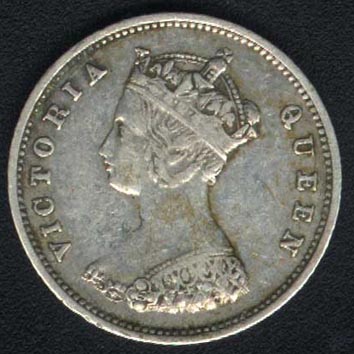 | 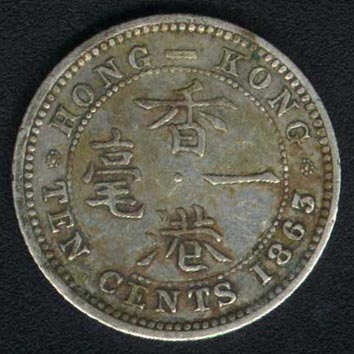 | No. 383 |
| Diam. 17.5 mm | ||
| Wt. 2.8 g. | ||
| Rareness C | ||
| Mint Evolution and Peculiarity | ||
Before I talk about Hong Kong silver coins, I would like to take this opportunity to pay a tribute to Mr. Ray hamson, author of "Regal Coinage of Hong Kong, Hong Kong Museum of History handbook, 1966". I was enlightened much by him, though I was not a collector 30 years ago. As he pointed out that: All silver issues of Hong Kong minted prior to 1885, (except 1876), can be considered to be very scarce in any condition." in his book. Actually, the production of Hong Kong subsidiary silver coins had a great increase after 1885. Most of them were widely circulated in Southern China as the Chinese eventually accepted them until 1890, China had her own coinage, which caused large amount of the Hong Kong coins returned to the conlony. This type of silver coin was first minted at the Royal Mint in London, starting in 1863. Inscriptions on the obverse of this coin are English VICTORIA QUEEN and Queen's crowned bust left. There are 10 pearls in right arch of the crown, this actually denotes the mintmark for Lindon Mint. [ Some of the 1866 ten cents were produced with 11 pearls in right arch of crown, they were minted by Hong Kong Mint. ] The Inscriptions on the reverse are four Chinese characters (means Hong Kong ten cents) in inner circle. In upper outer circle, English (Hong - Kong). Right and left small nine-dots rosettes. In lower outer circle (HONG KONG TEN CENTS 1863) indicating the denomination and date. The chief engraver of Royal Mint in London was Mr. Leonard C. Wyon at that time. Leonard Charles Wyon (23 November 1826 – 20 August 1891) was a British engraver of the Victorian era most notable for his work on the gold and silver coinage struck for the Golden Jubilee of Queen Victoria in 1887 and the bronze coinage of 1860 with the second ("bun") head portrait, in use from 1860 to 1894. Reference: Wikipedia | ||
| Obverse | Reverse | Description |
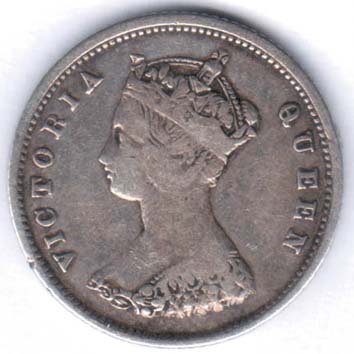 | 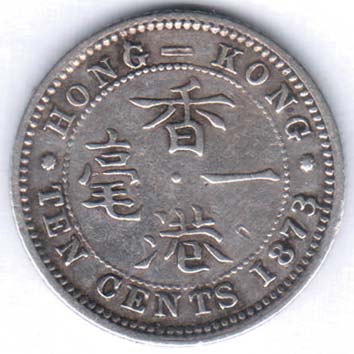 | No. 384 |
| Diam. 17.5 mm | ||
| Wt. 2.8 g. | ||
| Rareness C | ||
| Mint Evolution and Peculiarity | ||
In 1868 the Hong Kong Mint was closed, Heaton's Mint recommenced striking coins for Hong Kong from 1872. I do not have 1872H ten cents coin as it is very rare, for its low mintage of 88,000 pieces only. I have a ten cents coin dated 1873, though it is in lightly circulated condition. I am very happy with it. I recently got it from eBay, I thought its condition is acceptable to me. This coin was minted by Royal Mint in London. | ||
| Obverse | Reverse | Description |
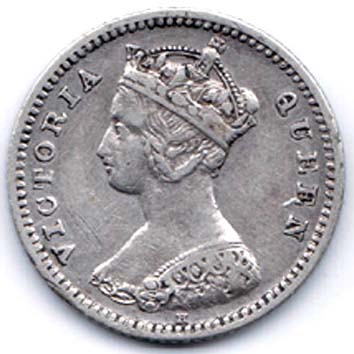 | 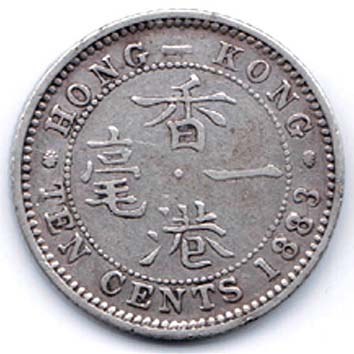 | No. 385 |
| Diam. 17.5 mm | ||
| Wt. 2.8 g. | ||
| Rareness C | ||
| Obverse | Reverse | Description |
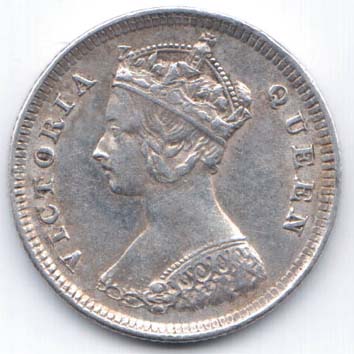 | 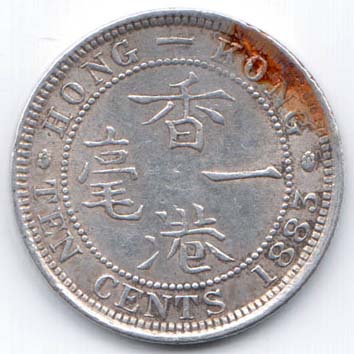 | No. 386 |
| Diam. 17.5 mm | ||
| Wt. 2.8 g. | ||
| Rareness C | ||
| Mint Evolution and Peculiarity | ||
There are two ten cents coins dated 1883. The first one was minted by R. Heaton & Sons Ltd. (now the Mint, Birmingham Ltd.). View the H below bust and the round-topped 3 in date as well as the bold and short hyphen between HONG-KONG please? The second one was minted by Royal Mint in London. It is similar to the first one, but a slightly different portrait of the Queen. Shaped (instead of flat) nose, with more pronounced nostril. Different "Q" in "QUEEN" with a simpler tail. Obverse rim beading less widely spaced. Longer hyphen than hitherto. Flat-topped 3 in date. | ||
| Obverse | Reverse | Description |
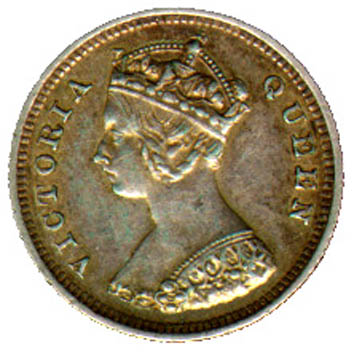 | 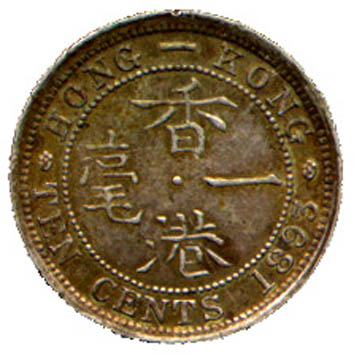 | No. 115 |
| Diam. 17.5 mm | ||
| Wt. 2.8 g. | ||
| Rareness D | ||
| Mint Evolution and Peculiarity | ||
This Queen Victoria's coin is in an extremely fine condition, all the original detail visible and only a light wear over the coin. You can see clearly not only the pearls and brocade at the top of the shoulder, but also the pearls on the lower rim of the crown and the hair above the eye. All these high points show slight wear only. This is an attractive coin. This coin was minted in England. As I know that Hong Kong Mint was closed in 1868, Hong Kong minor silver coins were struck again in England from 1872 onwards. Inscriptions on the obverse of this coin are English VICTORIA QUEEN and Queen's crowned bust left. The Inscriptions on the reverse are four Chinese characters (means Hong Kong ten cents) in inner circle. In upper outer circle, English (Hong - Kong). Right and left small rosettes. In lower outer circle (HONG KONG TEN CENTS 1893) indicating the denomination and date. | ||
| Obverse | Reverse | Description |
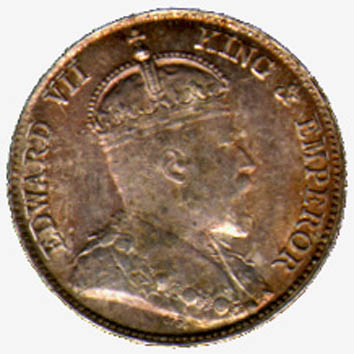 | 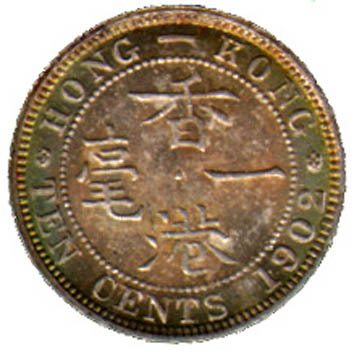 | No. 116 |
| Diam. 17.5 mm | ||
| Wt. 2.8 g. | ||
| Rareness D | ||
| Mint Evolution and Peculiarity | ||
This King Edward VII's 10 cents coin with attractive toning, is in an almost uncirculated condition, all details are visible. There is a little wear only on the highest point of the coin. There is half of the original mint luster present. It is difficult to get coin in nice condition, especially from the cat street. I collected it with HK$20 in Upper Lascar Row in 1990. I think I lost much, though HK$20 was too much for me at that time. I remembered that the hawker who had many ten cents coins of different dates. All his coins were in extremely fine condition and were sold at the same price of HK$20 each. But I thought that it was enough for me to have one specimen of each denomination in Hong Kong coins collecting. I had bought one piece only. The inscriptions of this coin are almost the same as the above coin except the crowned bust of King Edward VII instead of Queen Victoria and the date 1902 replaced 1893. | ||